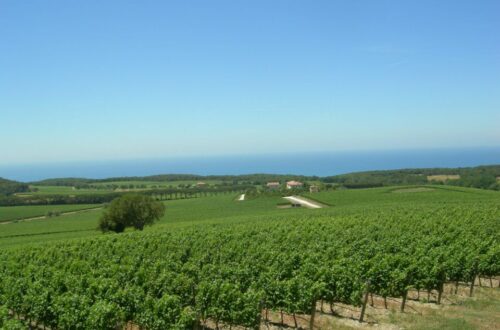Table of Contents
What is Barbera d’Asti DOCG?
Barbera d’Asti DOCG is one of Piedmont’s flagship red wines—a vibrant, food-friendly expression of the Barbera grape, known for its juicy red fruit, lively acidity, and approachability. Grown primarily in the Monferrato hills of Italy’s northwestern Piedmont region, Barbera d’Asti offers a more elegant and polished alternative to its rustic cousin Barbera del Monferrato, and stands distinct from the more structured Barbera d’Alba.
Recognized as a DOC in 1970 and elevated to DOCG status in 2008, Barbera d’Asti has become synonymous with quality, versatility, and the soul of Monferrato.
History and Origins
Barbera is one of the oldest and most widely planted grape varieties in Piedmont, with historical records dating back to the 13th century. While its exact origin is debated, it is deeply rooted in the Monferrato hills. For centuries, Barbera was considered the daily wine of the people—accessible, hearty, and reliably enjoyable. It wasn’t until the late 20th century that a quality revolution reshaped its identity.
Through improved vineyard management and modern winemaking techniques, Barbera d’Asti evolved from humble beginnings into a sophisticated wine capable of depth and aging. The DOCG status reflects this transformation and the appellation’s growing reputation on the global stage.
Where It’s Made: Geography & Terroir
Barbera d’Asti DOCG is produced in the southeastern portion of Piedmont, centered around the provinces of Asti and part of Alessandria. This is the heart of the Monferrato wine hills—a UNESCO World Heritage landscape celebrated for its rolling vineyards, medieval towns, and rich agricultural history.
Soils range from clay and limestone to sandy marl, contributing to a range of styles within the DOCG. Elevation, exposure, and microclimate all play key roles, giving producers ample diversity to craft both bright, early-drinking wines and more structured, age-worthy expressions.
The Grape: Barbera
Barbera is known for its deep ruby color, naturally high acidity, and low tannins. In Barbera d’Asti, this translates into a wine that is immediately appealing yet capable of complexity. The DOCG requires at least 90% Barbera, with up to 10% of other authorized non-aromatic red grapes from Piedmont.
Thanks to the region’s terroir and modern winemaking, Barbera d’Asti tends to show more finesse and balance than other Barbera expressions, making it a beloved choice among sommeliers and everyday wine lovers alike.
Winemaking & DOCG Regulations
The Barbera d’Asti DOCG sets strict regulations to preserve quality and typicity:
- Minimum alcohol: 12%
- Grape composition: At least 90% Barbera
- Aging: Standard Barbera d’Asti requires a minimum of four months of aging. The Superiore version must age at least 14 months, including six months in wood.
- Yield restrictions: Lower yields are mandated to improve concentration and quality.
The Superiore category allows producers to craft more structured wines with greater aging potential, often showing spice, vanilla, and deeper complexity.
Key Facts at a Glance
- Classification: DOCG (since 2008)
- Region: Piedmont (Asti and Alessandria provinces)
- Grape: Minimum 90% Barbera
- Styles: Regular and Superiore
- Price Range: $12 – $35 (USD)
Best Vintages: 2015, 2016, 2019, 2020
Tasting Notes
Barbera d’Asti typically offers a vivid aromatic profile of cherry, raspberry, plum, and violets, underpinned by refreshing acidity and a silky texture. Younger wines are fruit-forward and juicy, while aged and Superiore versions bring depth with notes of spice, leather, and dried herbs.
Expect a medium body, low to moderate tannins, and a bright, food-friendly finish.
Serving & Pairing
Barbera d’Asti is incredibly versatile at the table:
- Serving temperature: 16–18°C (60–64°F)
- Glassware: Use a universal or Burgundy-style glass to highlight aromas.
Ideal pairings:
- Agnolotti del plin (Piedmontese stuffed pasta)
- Salumi and aged cheeses
- Roasted poultry or pork
- Tomato-based pastas and pizzas
- Mushroom risottos
Its acidity cuts through rich dishes, while its soft tannins won’t overpower lighter fare.
Where to Buy & Pricing
Barbera d’Asti is widely available in both wine shops and online retailers specializing in Italian wine. It offers some of the best value in Piedmont, with excellent bottles from top producers starting around $15.
Notable producers include:
- Braida
- Michele Chiarlo
- Vietti
- Marchesi di Barolo
- La Spinetta
Look for Superiore or single-vineyard labels for a splurge-worthy upgrade.
FAQ on Barbera d’Asti
Is Barbera d’Asti DOC or DOCG?
As of 2008, Barbera d’Asti is officially recognized as a DOCG wine.
What does Barbera d’Asti taste like?
Expect bright red fruits, floral notes, high acidity, and a silky, medium-bodied palate.
Is it age-worthy?
Yes—especially Superiore styles, which can age 5–10 years.
How do you pronounce it?
Bar-BEH-rah dahs-TEE
What’s the difference between Barbera d’Asti and Barbera d’Alba?
Barbera d’Asti tends to be more elegant and acid-driven, while Barbera d’Alba is often richer and more structured due to different terroir.
Fun Facts & Cultural Notes
- In Piedmont, Barbera is affectionately called “la Barbera,” using the feminine article—a sign of deep local affection.
- The town of Nizza Monferrato has its own appellation (Barbera d’Asti Nizza DOCG), highlighting Barbera at its most powerful and age-worthy.
- Barbera d’Asti is a staple during local festivals and family meals in the region.


